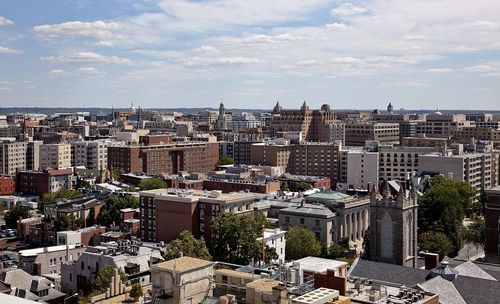Why affordable housing doesn’t stay affordable forever
We often hear that DC is losing affordable housing. In most cases, that means existing dwellings hitting a point where rents go up or building owners sell at market rates. Here’s how “expiration dates” for affordable housing work.

Photo by Carol Highsmith.
Programs like DC’s Housing Production Trust Fund, DC’s largest housing program, require the housing it helps pay for to remain affordable for a set number of years. Broadly speaking, that means the building can only be rented to people below a certain income level, and rent can’t go above a certain level. This amount could be 30 percent of the tenant’s income, meaning a tenant’s rent can rise or fall if they lose or gain income.
Affordable units like this use federal rental subsidies that pay the difference between what the tenant pays on any given month and an agreed-upon amount. That, or the maximum rent could be based on the most someone at a certain income level could afford (independent of whether the actual tenant is at or below that income level). Housing built using federal low-income housing tax credits usually works this way.
But after time passes, owners are free to convert their buildings to market-rate housing. Among housing programs in the District, affordability terms can be short as 30 years for rental housing and five years for homeownership housing.
When entire buildings of low-cost housing are lost because the affordability restrictions expired, low-income residents are displaced from their homes and communities, and it is expensive and often impossible for the city to rebuild the lost housing — especially in high-demand neighborhoods with access to transit and jobs.
Affordability requirements don’t have to be limited
Affordability requirements have traditionally been set to expire for a few reasons. One is that affordable rents and replacement reserves (funds set aside to pay for the building’s future needs) aren’t always enough to pay for repairs as buildings wear out and need to be fixed. Hiking rents after a few decades can pay for re-investments like new plumbing, windows, roofs and boilers.
The other is that some affordable housing projects count on profits from higher rents in the future to fill out the return on investment (though this isn’t all that common given that most affordable housing developers aren’t for-profit).
But what if affordable housing built with public dollars had no expiration date? A decade ago, housing officials from Boston decided all projects receiving public subsidy had to agree to stay affordable permanently. After seeing the city’s past housing investments evaporate as affordability terms expired, Boston’s Neighborhood Development Department (Boston’s version of DC’s Department of Housing and Community Development) did the following to help make permanent affordability more financially feasible:
- It put more dollars into affordable housing up-front to ensure buildings could stay in good condition long-term. That meant funding a larger reserve, so that over the years, building owners could replace failing boilers, roofs, windows, plumbing, and more without needing to raise rents.
- It structured deals with affordable housing developers so that getting a return on investment didn’t mean eventually hiking rents.
- It created plans to step in if buildings ran into trouble. Even with the best up-front planning, it’s possible some properties will need to assistance with financing down the line, and Boston assured developers it’d be ready with solutions if developers encountered unforeseen problems.
Could DC follow Boston’s lead?
The District has adopted permanent affordability for some of its housing programs — affordable housing built on land sold by the District, and housing produced by inclusionary zoning, remain affordable as long as the building stands — but not for all of its housing programs.
For example, housing preserved or built using funds from the Housing Production Trust Fund are affordable for only 40 years, not permanently.
That are some people in DC’s affordable housing world who think the District would get better bang for its buck by adopting a permanent affordability requirement like Boston’s.The District is investing record amounts in affordable housing, yet that housing may not be there for future generations of DC residents if we let it expire.
